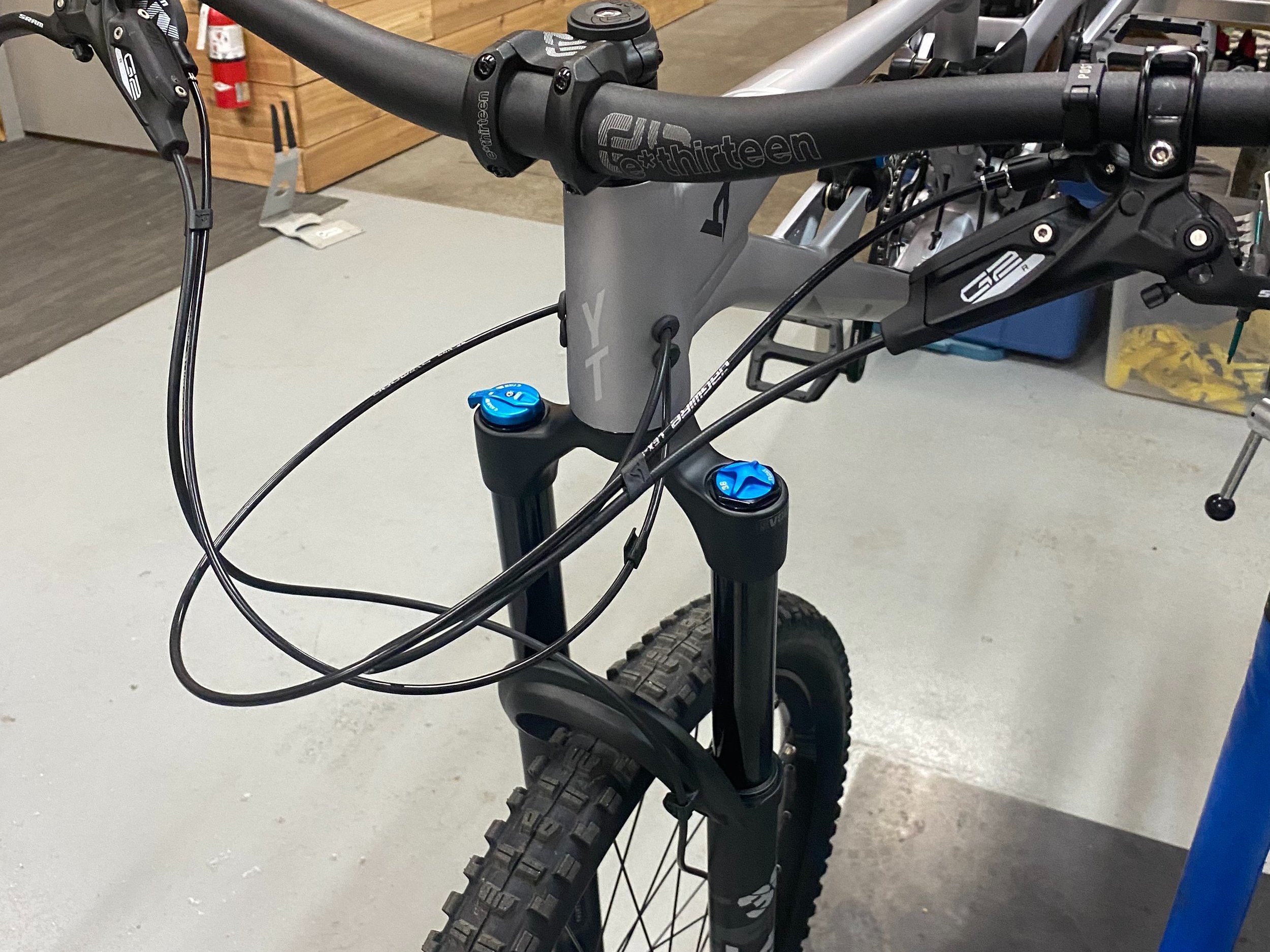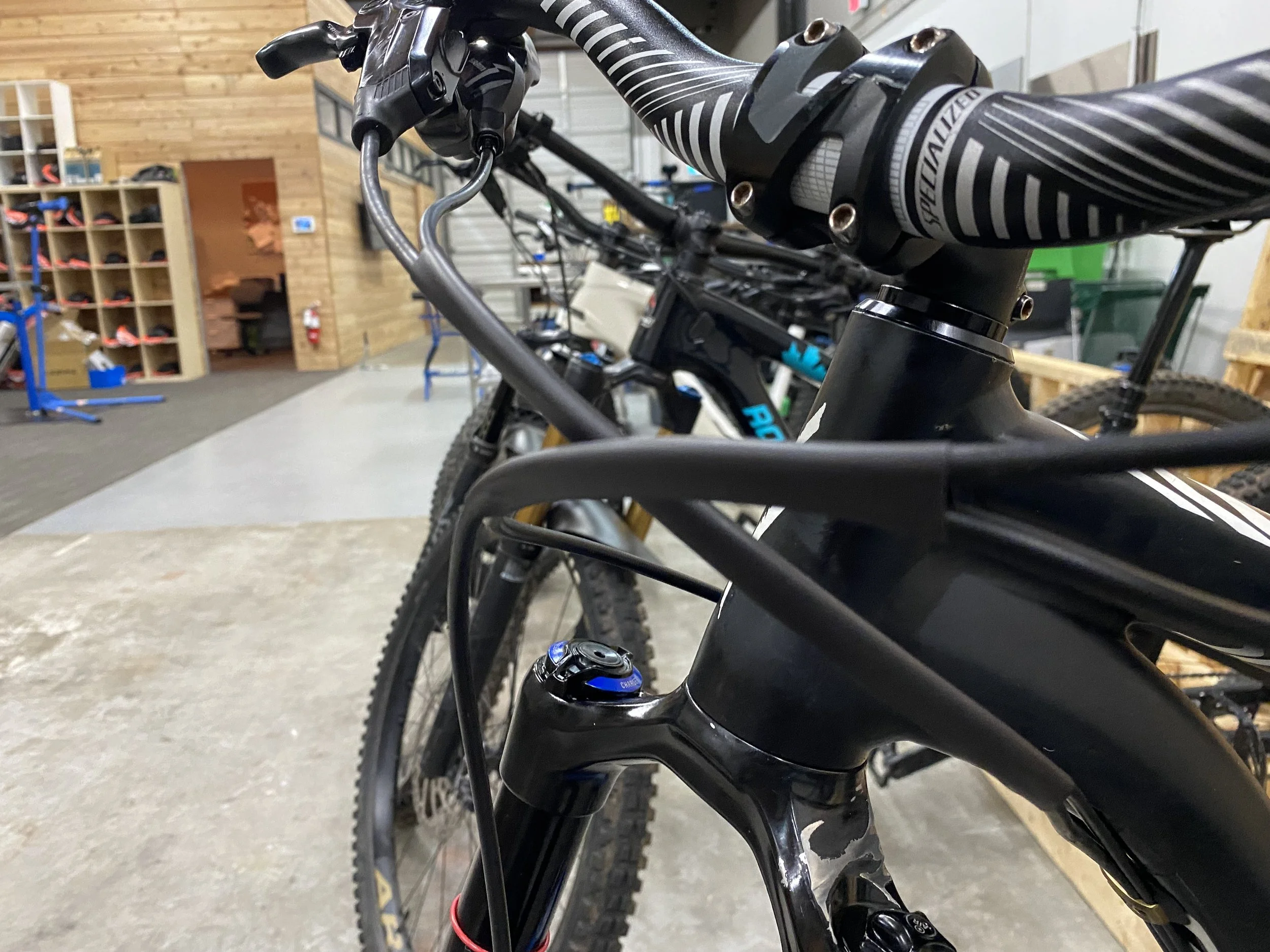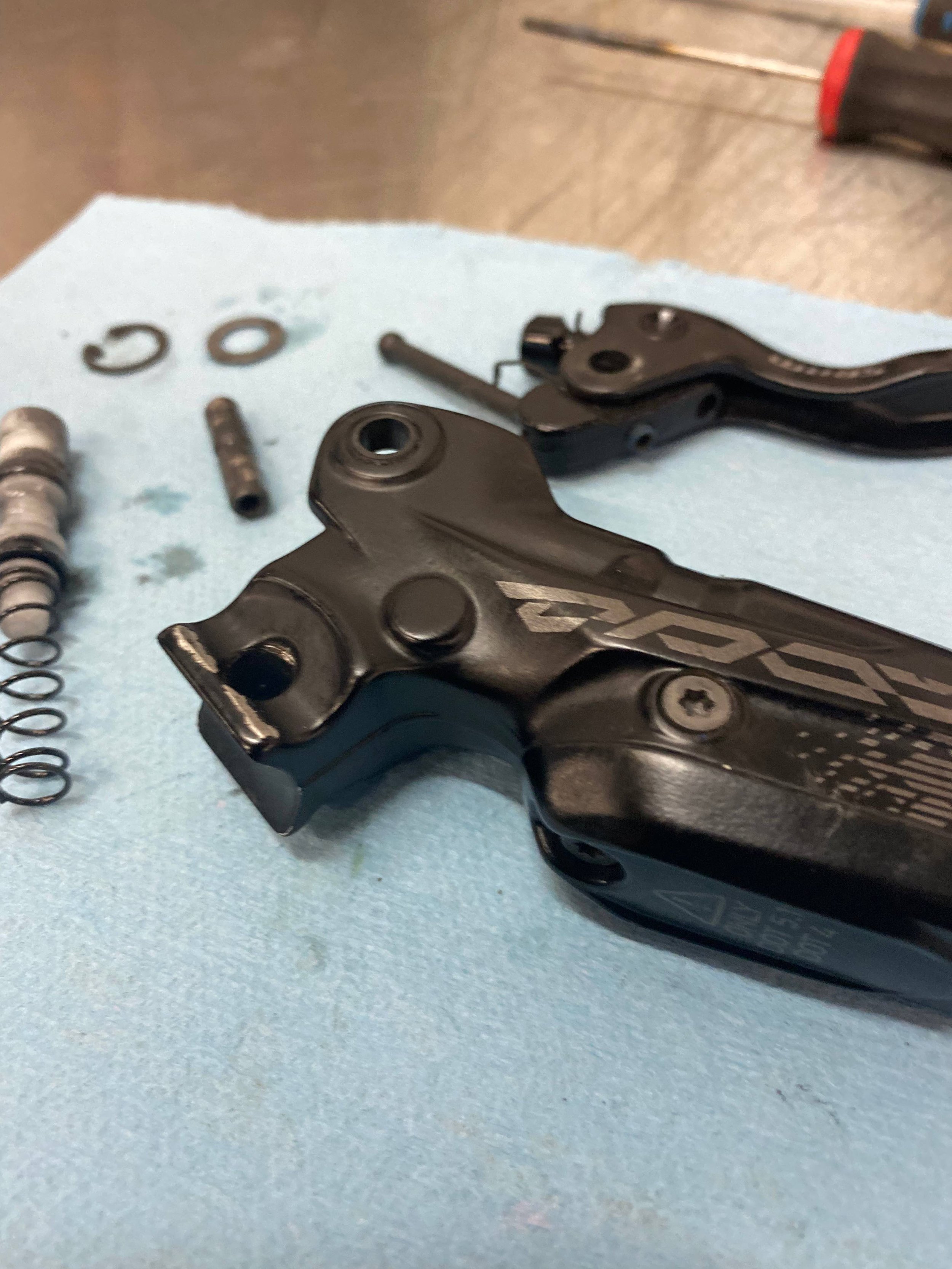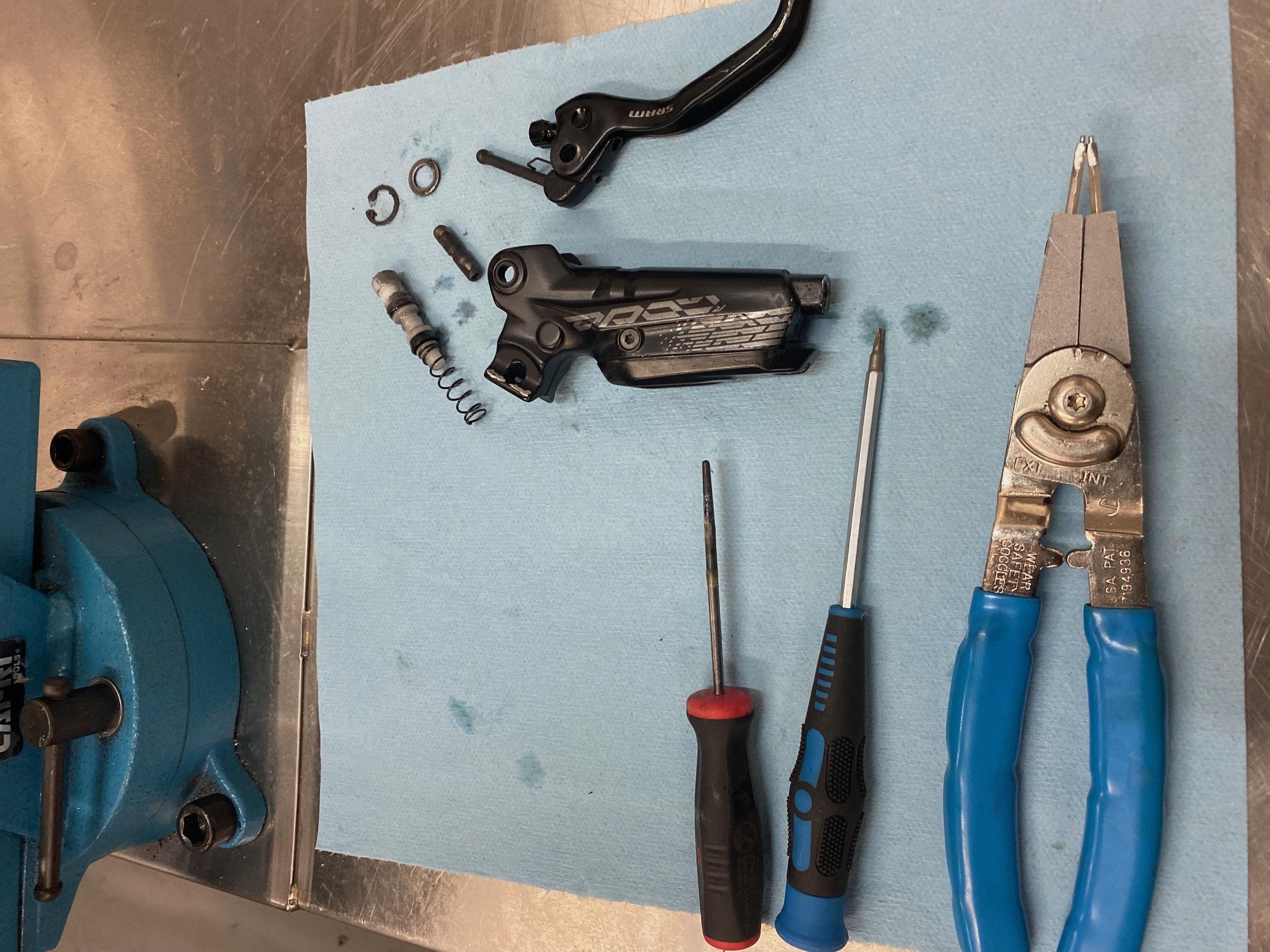The Brake Down
posted by Ash Kelly
it’s been a long, hot, dusty season followed by a tonne of rain, a weather bomb and atmospheric rivers flowing overhead. so, how are your brakes doing?
brakes are impacted by heat, water, mud, corrosion and rust, wearing parts, and so many more variables. obviously, how your brakes feel impacts your riding confidence, stopping power and can be the last thing standing between you and an all-time wipe out in front of the crew.
this thing is, while most of us understand that hydraulic disc brakes need to be bled regularly, to flush air and contaminates out of the system, there’s much more to ACHIEVING a “solid” brake feel than just having a perfect brake bleed.
we charge $45/brake bleed at dialed bike service. this might actually be a bit more than you’re used to paying, and you could just buy a bleed kit and some fluid and do it yourself, right? so why pay for a full brake service at a bike shop and why at our shop in particular? because we don’t just bleed your brake, we inspect and reset the whole system.
we like to compare brake bleeds to that six-month checkup at the dentist (but, like, a nice dentist who understands if you only floss when your significant other is watching). even if you’re aces at bleeding there are some things it helps to have a PROFESSIONAL diagnose and correct before those problems gets worse.
Like a dental checkup, this isn’t just about cleaning, it’s about identifying all of the other issues underneath the plaque and tartar: cavities, gum recession, halitosis, etc. a customer of ours actually said it best imho: “you wouldn’t want a dentist who only tells you about one cavity if you have three.”
a brake bleed at dialed includes a whole-system check-up, where we diagnose underlying issues that can grow into big, expensive problems if not dealt with early on.
similarly, a brake bleed isn’t just about removing air from your hoses and system, it’s about ensuring when you squeeze that lever in a moment of need, the fluid pressurizes instantly, actuating a chain reaction of pistons, springs, seals, pads and finally squeezing the brake rotor evenly from both sides. and there is a lot of cleaning: it’s is a big part of brake maintenance and if done incorrectly can also leave behind films and residues that impact your stopping power, make your rotors squeal and can even dry out important seals.
we go beyond the bleed kit to guarantee your brakes will be at their absolute best when we hand your bike back and we will also offer up the finer details of service, like shrink wrapping your brake and shifter cables. shrink wrapping and proper cable routing prevents damage to the hoses caused by rubbing on other hoses, the frame or being smashed ina. crash.
damage to the hoses can result in a catastrophic failure of the system if not caught early as the pressure inside the line can be enough to burst through a damaged hose and cause full failure.



from nose to tail your brakes are made up of a lever/bladder system that includes a master cylinder piston and return spring and a number of seals connected by a to the calliper, where two to four more pistons ACTUATE, pushing the brake pads into the disc to make a sort of brake sandwich.
we often hear the term “modulation” when we talk about brake performance, and the calliper pistons play the biggest role in how well your system modulates, meaning the range of effective power from contact point to full-stop.
what may be surprising for a lot of riders is how essential that brake sandwich is to achieving the crisp “lever feel” most of us are aiming for. if calliper pistons aren’t moving freely, and evenly, you’re going to feel that very time you squeeze the lever blade looking for power.
when we bleed brakes in our shop and know we’ve gotten the air out of the system, but we still feel that unwanted “squishiness” at the lever, we know something else in the system is at play. this is the case with most brakes we see, over time issues develop and what is assumed to be the fault of the brake fluid is so often a mechanical issue to do with one moving part or another.
so how do we make sure every customer gets crisp brakes and is experiencing the maximum power of these pricey and important safety-associated components?
every brake bleed at dialed includes an full inspection, pad spacing, a basic rotor/calliper alignment and a basic rotor true at no extra charge. (some brakes need more than an average service and we do reserve the ability to charge more for work that needs more time).
because we know nearly every single brake is going to need some in-depth work to perform at it’s prime, we build this into the price. we can’t stand doing half a job and having you back just 2 weeks or a month later, our PHILOSOPHY is to get all done at once - we call it the whole bike approach and we adhere to it for every repair.
so what are you getting? first, we start with an inspection of the system, checking the line and connection points for damage or leaks, then check how much life is left in the brake pads themselves. we RECOMMEND replacing pads if they have >25% life.
before the bleed we remove both wheels so the brake rotors won’t be contaminated if any brake fluid or oil spills or squirts out during the bleed. then we remove the brake pads and clean inside of the callipers with a degreaser and a number of small, specialized brushes.
we also inspect and clean/restore your rotor and pads if they have become contaminated, or replace them if necessary. every single bolt we remove during a brake srvice, including rotor bolts, are cleaned of old thread lock and reinstalled with fresh, quality thread treatments. (sometimes this can cost extra if things are badly damaged or very contaminated).
at this point we also inspect your calliper pistons, where a lot of issues can occur, including “sticky pistons” meaning one or more piston is either slower than the others in its outward travel, toward the pad and rotor, or refuses to return to its starting position after the lever is released.
dirty, “sticky” callipers pull mud, water and other contaminants and even air into your system degrading the performance of your fancy parts. over time, they can become slow or even seized and wont push toward the pads/rotor evenly, creating that unWanted “squish,” even with a good, solid bleed.
the thing is, It takes a bit of know-how and a few tools/fluids/elbow grease to clean and massage those babies back into working condition but, again, this is such an essential check we include a basic calliper clean and piston massage with your bleed when we find this issue (some brakes are quite far gone, and if this is the case we do charge extra labour for our time spent disassembling, cleaning and re-assembling the calLiper).
after the bleed, with the wheels are still out of the frame, we return to the calliper and replace the brake pads, space those pads with varying widths of inserts until both pistons are moving back and forth evenly and their contact point with the pad spacer is in the centre of the calliper.
wheels go back in, and we check that the calliper is properly aligned with the disc in the centre of the pads, if this isn’t the case, and it usually isn’t, we loosen the calliper mounting bolts and carefully align the rotor in the centre.
Of course, this only works of your rotor is true and straight - and most neglected brake systems are accompanied by warped or badly bent rotors, so we take the time to return your rotors to as true a state as possible. sometimes, rotors are just too far gone to be repaired and it’s best to replace them.
if you’ve opted to replace your brake pads at the shop, we also “bed” them in for you. This integrates the materials of the pad with the materials of the rotor.
the process involves dragging the brakes in their on position, which we do for you by riding the bike and holding the lever down while pedalling. it can be quite a workout for the mechanics.
you can also achieve this by dragging the brakes while slowly riding down a hill on the road, but you want to avoid doing this on the trail or on your first ride with new pads, because short intermittent pressure is not effective at pad/rotor integration.
an average brake bleed likely only takes about 15 minutes or so if all goes well. but a Bleed is only part of a brake SERVICE, and even if it feels great at first, there’s a very, very high LIKELIHOOD that there’s a lot more that could be done to maximize your braking power and modulation and if it’s not done you’ll be left thinking you just paid for a crap bleed at a shop. obviously, that’s not what we want, so we put in the extra time to make sure that doesn’t happen.
this summer, perhaps because of the three heat waves we faced in B.C., we saw HORDES of sram brakes coming in with swollen piston levers. if you’re riding with a sticky, slow-to-return SRAM lever, we have good news! We’ve now got the replacement parts in stock for a number of models, meaning we can repair the issue next time you book in for a bleed.
the thing is you have to bleed your brake after this service, because you’ve cracked the system wide-open at the lever, so we DEFINITELY suggest having this issue fixed if you’re already due for your next brake bleed anyhow.
in terms of safety and control, your brakes are arguable the most important component on your bike and they are often some of the more expensive pieces as well.
regardless of how old or new your bikes is, what brakes you’re running and what kind of fluid they use, regular maintenance beyond the bleed is an absolute necessity.
We’re happy to be offering a 2-for-1 bleed deal, which includes a full inspection, basic cleaning, basic rotor true and calliper alignment in the price. book online before november 10th to get in on this deal. (offer is only available through online booking)









